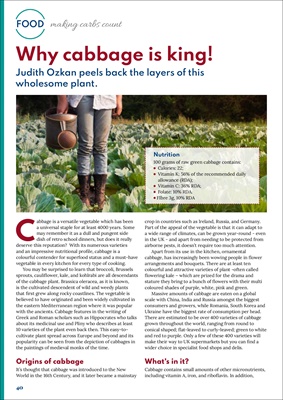
40
FOOD making carbs count
Why cabbage is king!
Judith Ozkan peels back the layers of this
wholesome plant.
Cabbage is a versatile vegetable which has been
a universal staple for at least 4000 years. Some
may remember it as a dull and pungent side
dish of retro school dinners, but does it really
deserve this reputation? With its numerous varieties
and an impressive nutritional profile, cabbage is a
colourful contender for superfood status and a must-have
vegetable in every kitchen for every type of cooking.
You may be surprised to learn that broccoli, Brussels
sprouts, cauliflower, kale, and kohlrabi are all descendants
of the cabbage plant. Brassica oleracea, as it is known,
is the cultivated descendent of wild and weedy plants
that first grew along rocky coastlines. The vegetable is
believed to have originated and been widely cultivated in
the eastern Mediterranean region where it was popular
with the ancients. Cabbage features in the writing of
Greek and Roman scholars such as Hippocrates who talks
about its medicinal use and Pliny who describes at least
10 varieties of the plant even back then. This easy-tocultivate
plant spread across Europe and beyond and its
popularity can be seen from the depiction of cabbages in
the paintings of medieval monks of the time.
Origins of cabbage
It's thought that cabbage was introduced to the New
World in the 16th Century, and it later became a mainstay
crop in countries such as Ireland, Russia, and Germany.
Part of the appeal of the vegetable is that it can adapt to
a wide range of climates, can be grown year-round - even
in the UK - and apart from needing to be protected from
airborne pests, it doesn't require too much attention.
Apart from its use in the kitchen, ornamental
cabbage, has increasingly been wowing people in flower
arrangements and bouquets. There are at least ten
colourful and attractive varieties of plant -often called
flowering kale - which are prized for the drama and
stature they bring to a bunch of flowers with their multi
coloured shades of purple, white, pink and green.
Massive amounts of cabbage are eaten on a global
scale with China, India and Russia amongst the biggest
consumers and growers, while Romania, South Korea and
Ukraine have the biggest rate of consumption per head.
There are estimated to be over 400 varieties of cabbage
grown throughout the world, ranging from round to
conical shaped; flat-leaved to curly-leaved; green to white
and red to purple. Only a few of these 400 varieties will
make their way to UK supermarkets but you can find a
wider choice in specialist food shops and delis.
What's in it?
Cabbage contains small amounts of other micronutrients,
including vitamin A, iron, and riboflavin. In addition,
Nutrition
100 grams of raw green cabbage contains:
Calories: 22;
very little protein or fibre;
Vitamin K: 56% of the recommended daily
allowance (RDA);
Vitamin C: 36% RDA;
Folate: 10% RDA.